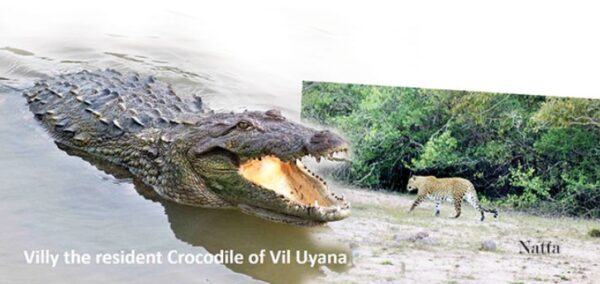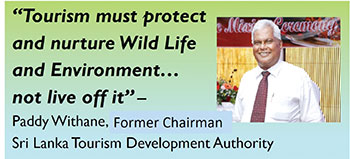Tourism: Need for ‘colourful stories’ to promote wildlife-by Srilal Miththapala

Source:Island
Stakeholders in marketing Sri Lanka tourism should be creating colourful stories of the wildlife experiences in Sri Lanka instead of presenting basic facts and figures.
We need to create and tell wildlife stories with a humane touch.
 When a potential tourist calls a hotel or a travel agency to inquire about the wildlife attractions in Sri Lanka, most often the sales staff just give an itinerary and mention the animals that could be observed instead of portraying wildlife in an attractive manner.
When a potential tourist calls a hotel or a travel agency to inquire about the wildlife attractions in Sri Lanka, most often the sales staff just give an itinerary and mention the animals that could be observed instead of portraying wildlife in an attractive manner.
This would require private sector tourism professionals to have high levels of wildlife experience and enthusiasm, and the message has to go down to the employees who communicate with tourists. Meanwhile, most hotels now have naturalists on their payroll, and such hotels should encourage them to engage in creating stories for tourists to enjoy the wildlife in the area.
Over the years I have been presenting many stories of charismatic wild animal individuals.
 Amongst many others, I have written copiously on
Amongst many others, I have written copiously on
*Rambo the wild elephant who patrols the bund of the Uda Walawe National Park
*The late and great Walawe Raja undisputed king of Uda Walawe for decades,
*Gemunu the mischievous wild elephant of Yala National Park, who raids visitor vehicles for food,
*Hamu and Ivan, the mature, street-smart, male leopards ( the later now deceased) also of Yala National park,
*Natta the iconic male leopard and the coy Cleo, the mature female leopard of Wilpattu National Park, and
*Timothy and Tabitha , the two semi -tame giant squirrels at the Seenuggala Bungalow inside the Uda Walawe park.
I have extracted their ‘antics’ and built characters around them. And I do not apologise for ‘humanising’ them. That’s what makes it all the more interesting to people.
I recently took the story of the resident crocodile Villy at Jet Wing Vil Uyana Hotel, and spun a whole story around it.
Africa may have their ‘Big Five’ animals, but we also have our own ‘Big Four’ mammals; the blue whale, elephant, leopard and the sloth bear. ( some of my colleagues talk about our ‘Big Five’ adding the sperm whale also to this list. But I do not agree on having two of the same species on the list).
Sri Lanka has almost 30 percent of some sort of green cover, over 3,000 plants and over 1,000 animal species. So we certainly do not have a shortage of good wildlife tourism promotional material.
Hence I wonder if Sri Lanka really needs high numbers of tourists, or should we pursue a different strategy of quality over quantity?
Sri Lanka welcomed 2.3 million tourists in 2018, earning approximately US$ 4.4 billion in revenue. (2018 is best base-case scenario, because in 2019 we had the terrorist attacks, and subsequently we had the Covid Pandemic)

Wildlife tourism is a steadily growing segment and Wikipedia says that Wildlife tourism currently employs 22 million people worldwide directly or indirectly, and contributes more than $ 120 billion to global GDP.
Even in Sri Lanka we have seen a dramatic increase in this segment. In 2018 almost 50% of all tourists to the country visited at least one of the wild life parks, up from 38% in 2015. The Dept. of Wildlife Conservation earned a staggering Rs 2,1 Billion in 2018 from foreign ticket sales.
However, it must be stressed that the tourism industry has to act as the guardian of the wildlife attractions in Sri Lanka instead of causing their degradation, regarding which the private sector has to be vigilant and responsible about.







